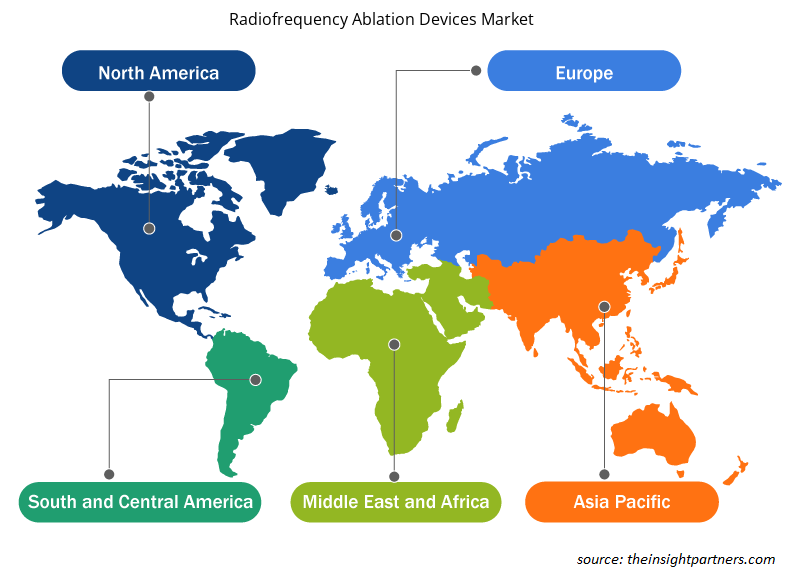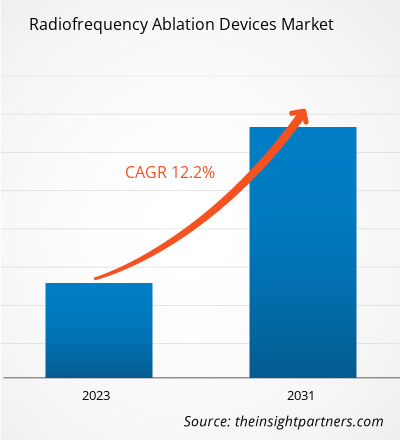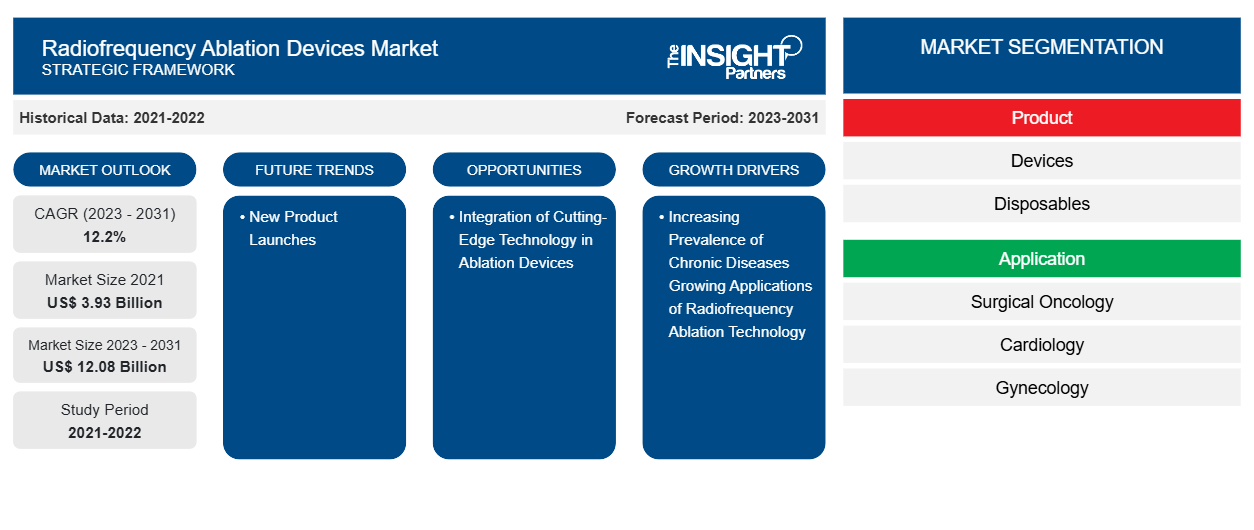Der Markt für Radiofrequenzablationsgeräte belief sich 2021 auf 3,93 Milliarden US-Dollar und soll von XX Milliarden US-Dollar im Jahr 2023 auf 12,08 Milliarden US-Dollar im Jahr 2031 anwachsen. Der Markt dürfte zwischen 2023 und 2031 eine durchschnittliche jährliche Wachstumsrate (CAGR) von 12,2 % verzeichnen. Die Integration modernster Technologie in Ablationsgeräte dürfte ein wichtiger Markttrend für Radiofrequenzablationsgeräte bleiben.
Marktanalyse für Radiofrequenzablationsgeräte
Radiofrequenzgeräte werden häufig in der Krebsbehandlung, Kardiologie, Gynäkologie, Kosmetik und Schmerztherapie eingesetzt. Die Nachfrage nach Radiofrequenzen ist aufgrund der zunehmenden Verbreitung von Herz-Kreislauf-Erkrankungen, insbesondere Vorhofflimmern, und der zunehmenden Präferenz für minimalinvasive Verfahren gestiegen . Radiofrequenzgeräte weisen eine hohe Erfolgsquote bei der Behandlung von Vorhofflimmern auf, was die Produktakzeptanz erhöht und das Marktwachstum begünstigt hat.
Marktübersicht für Radiofrequenzablationsgeräte
Die Radiofrequenzablation ist eine interventionelle Methode, die in vielen medizinischen Bereichen eingesetzt wird, beispielsweise zur Behandlung von Herzrhythmusstörungen und zur Entfernung von Tumoren an verschiedenen Stellen. Hersteller entwickeln Ablationsgeräte, mit denen bestimmte oder erkrankte Gewebe mithilfe von Technologien wie Radiofrequenz, robotergestützten Operationen, Elektrizität, Ultraschall und Laser zerstört werden können. Ablationsgeräte sind zu einer beliebten und wirksamen Behandlungsmethode für chronische Bronchitis, Krebs, unregelmäßigen Herzschlag und Nervenbeschwerden geworden.
Passen Sie diesen Bericht Ihren Anforderungen an
Sie erhalten kostenlos individuelle Anpassungen an jedem Bericht, einschließlich Teilen dieses Berichts oder einer Analyse auf Länderebene, eines Excel-Datenpakets sowie tolle Angebote und Rabatte für Start-ups und Universitäten.
-
Holen Sie sich die wichtigsten Markttrends aus diesem Bericht.Dieses KOSTENLOSE Beispiel umfasst eine Datenanalyse von Markttrends bis hin zu Schätzungen und Prognosen.
Markttreiber und Chancen für Radiofrequenzablationsgeräte
Zunehmende Anwendungen treiben den Markt für Radiofrequenzablationstechnologie voran
In den letzten Jahren wird die Technik auch zur Behandlung von Patienten mit Nebennieren-, Leber-, Brust-, Knochen-, Bauchspeicheldrüsen-, Nieren-, Lungen- und Schilddrüsenkrebs eingesetzt , obwohl sie keine primäre Krebsbehandlung darstellt. Neben der Onkologie wird die Radiofrequenzablationstechnologie auch zur Behandlung von Patienten mit Herzerkrankungen eingesetzt, wenn Medikamente oder andere Behandlungen diese Erkrankungen nicht heilen können.
Neue Produkteinführungen bieten lukrative Möglichkeiten
Die Akteure auf dem Markt für Radiofrequenzablationsgeräte entwickeln zahlreiche und fortschrittliche Produkte für Radiofrequenzablationsverfahren. So hat NeuroOne Medical Technologies im März 2024 eine begrenzte Markteinführung seines OneRF-Ablationssystems eingeleitet, das über die 510(k)-Zulassung der US-amerikanischen Food and Drug Administration (FDA) für die Erzeugung von Radiofrequenzläsionen (RF) in Nervengewebe für funktionelle neurochirurgische Verfahren verfügt.radiofrequency ablation devices market are coming up with multiple and advanced products for radiofrequency ablation procedures. For instance, in March 2024, NeuroOne Medical Technologies has initiated a limited commercial launch of its OneRF ablation system, which has US Food and Drug Administration (FDA) 510(k) clearance for creation of radiofrequency (RF) lesions in nervous tissue for the functional neurosurgical procedures.
Marktbericht zu Radiofrequenzablationsgeräten – Segmentierungsanalyse
Wichtige Segmente, die zur Ableitung der Marktanalyse für Radiofrequenzablationsgeräte beigetragen haben, sind Produkt und Anwendung.
- Basierend auf dem Produkt ist der Markt für Radiofrequenzablationsgeräte in Geräte und Einwegprodukte unterteilt. Das Segment Einwegprodukte hatte im Jahr 2023 einen größeren Marktanteil.
- Nach Anwendung ist der Markt in chirurgische Onkologie, Kardiologie, Kosmetologie, Gynäkologie und Schmerztherapie segmentiert. Das Segment chirurgische Onkologie hatte im Jahr 2023 den größten Marktanteil.
Marktanteilsanalyse für Radiofrequenzablationsgeräte nach Geografie
Der geografische Umfang des Marktberichts zu Geräten zur Radiofrequenzablation ist hauptsächlich in fünf Regionen unterteilt: Nordamerika, Asien-Pazifik, Europa, Naher Osten und Afrika sowie Süd- und Mittelamerika.
Nordamerika dominiert den Markt für Radiofrequenzablationsgeräte. Zunehmende Fälle chronischer Krankheiten wie Herz-Kreislauf-Erkrankungen und Krebs, zunehmender Wettbewerb zwischen den Marktteilnehmern und hohe Ausgaben für Forschung und Entwicklung sind einige der Hauptfaktoren, die das Marktwachstum in Nordamerika vorantreiben.
Regionale Einblicke in den Markt für Radiofrequenzablationsgeräte
Die regionalen Trends und Faktoren, die den Markt für Radiofrequenzablationsgeräte während des Prognosezeitraums beeinflussen, wurden von den Analysten von Insight Partners ausführlich erläutert. In diesem Abschnitt werden auch die Marktsegmente und die Geografie von Radiofrequenzablationsgeräten in Nordamerika, Europa, im asiatisch-pazifischen Raum, im Nahen Osten und Afrika sowie in Süd- und Mittelamerika erörtert.

- Erhalten Sie regionale Daten zum Markt für Radiofrequenzablationsgeräte
Umfang des Marktberichts zu Radiofrequenzablationsgeräten
| Berichtsattribut | Details |
|---|---|
| Marktgröße im Jahr 2021 | 3,93 Milliarden US-Dollar |
| Marktgröße bis 2031 | 12,08 Milliarden US-Dollar |
| Globale CAGR (2023 - 2031) | 12,2 % |
| Historische Daten | 2021-2022 |
| Prognosezeitraum | 2023–2031 |
| Abgedeckte Segmente |
Nach Produkt
|
| Abgedeckte Regionen und Länder |
Nordamerika
|
| Marktführer und wichtige Unternehmensprofile |
|
Marktteilnehmerdichte für Radiofrequenzablationsgeräte: Auswirkungen auf die Geschäftsdynamik verstehen
Der Markt für Radiofrequenzablationsgeräte wächst rasant, angetrieben durch die steigende Endverbrauchernachfrage aufgrund von Faktoren wie sich entwickelnden Verbraucherpräferenzen, technologischen Fortschritten und einem größeren Bewusstsein für die Vorteile des Produkts. Mit steigender Nachfrage erweitern Unternehmen ihr Angebot, entwickeln Innovationen, um die Bedürfnisse der Verbraucher zu erfüllen, und nutzen neue Trends, was das Marktwachstum weiter ankurbelt.
Die Marktteilnehmerdichte bezieht sich auf die Verteilung der Firmen oder Unternehmen, die in einem bestimmten Markt oder einer bestimmten Branche tätig sind. Sie gibt an, wie viele Wettbewerber (Marktteilnehmer) in einem bestimmten Marktraum im Verhältnis zu seiner Größe oder seinem gesamten Marktwert präsent sind.
Die wichtigsten auf dem Markt für Radiofrequenzablationsgeräte tätigen Unternehmen sind:
- Avanos Medical Inc.,
- Stryker,
- Abbott,
- Medtronic,
- Boston Scientific,
- Barde (BD),
Haftungsausschluss : Die oben aufgeführten Unternehmen sind nicht in einer bestimmten Reihenfolge aufgeführt.

- Überblick über die wichtigsten Akteure auf dem Markt für Radiofrequenzablationsgeräte
Marktnachrichten und aktuelle Entwicklungen zu Geräten zur Radiofrequenzablation
Der Markt für Radiofrequenzablationsgeräte wird durch die Erhebung qualitativer und quantitativer Daten nach Primär- und Sekundärforschung bewertet, die wichtige Unternehmensveröffentlichungen, Verbandsdaten und Datenbanken umfasst. Im Folgenden finden Sie eine Liste der Entwicklungen auf dem Markt für Radiofrequenzablationsgeräte:
- AtriCure, Inc., ein führender Innovator in chirurgischen Behandlungen und Therapien für Vorhofflimmern (Afib), Behandlung des linken Vorhofohrs (LAA) und postoperative Schmerzbehandlung, gab bekannt, dass es die EnCompass-Klemme, einen Teil des Isolator Synergy Ablation Systems, in den Vereinigten Staaten auf den Markt gebracht hat. Die EnCompass-Klemme erhielt die FDA 510(k)-Zulassung für die Ablation von Herzgewebe während Herzoperationen und soll begleitende chirurgische Ablationen effizienter machen. (Quelle: ATRICURE, INC., Pressemitteilung, 2022)
- BD (Becton, Dickinson, and Company), ein weltweit führendes Medizintechnikunternehmen, gab heute die Übernahme von Venclose, Inc. bekannt, einem Anbieter von Lösungen zur Behandlung der chronischen Veneninsuffizienz (CVI) – einer Krankheit, die durch eine Fehlfunktion der Venenklappen entsteht und zu Krampfadern führen kann. (Quelle: BD, Pressemitteilung, 2021)
Marktbericht zu Geräten zur Radiofrequenzablation – Umfang und Ergebnisse
Der Bericht „Marktgröße und Prognose für Radiofrequenzablationsgeräte (2021–2031)“ bietet eine detaillierte Analyse des Marktes, die die folgenden Bereiche abdeckt:
- Marktgröße und Prognose auf globaler, regionaler und Länderebene für alle wichtigen Marktsegmente, die im Rahmen des Projekts abgedeckt sind
- Marktdynamik wie Treiber, Beschränkungen und wichtige Chancen
- Wichtige Zukunftstrends
- Detaillierte PEST/Porters Five Forces- und SWOT-Analyse
- Globale und regionale Marktanalyse mit wichtigen Markttrends, wichtigen Akteuren, Vorschriften und aktuellen Marktentwicklungen
- Branchenlandschaft und Wettbewerbsanalyse, einschließlich Marktkonzentration, Heatmap-Analyse, prominenten Akteuren und aktuellen Entwicklungen
- Detaillierte Firmenprofile
- Historische Analyse (2 Jahre), Basisjahr, Prognose (7 Jahre) mit CAGR
- PEST- und SWOT-Analyse
- Marktgröße Wert/Volumen – Global, Regional, Land
- Branchen- und Wettbewerbslandschaft
- Excel-Datensatz
Aktuelle Berichte
Erfahrungsberichte
Grund zum Kauf
- Fundierte Entscheidungsfindung
- Marktdynamik verstehen
- Wettbewerbsanalyse
- Kundeneinblicke
- Marktprognosen
- Risikominimierung
- Strategische Planung
- Investitionsbegründung
- Identifizierung neuer Märkte
- Verbesserung von Marketingstrategien
- Steigerung der Betriebseffizienz
- Anpassung an regulatorische Trends























 Kostenlose Probe anfordern für - Markt für Radiofrequenzablationsgeräte
Kostenlose Probe anfordern für - Markt für Radiofrequenzablationsgeräte